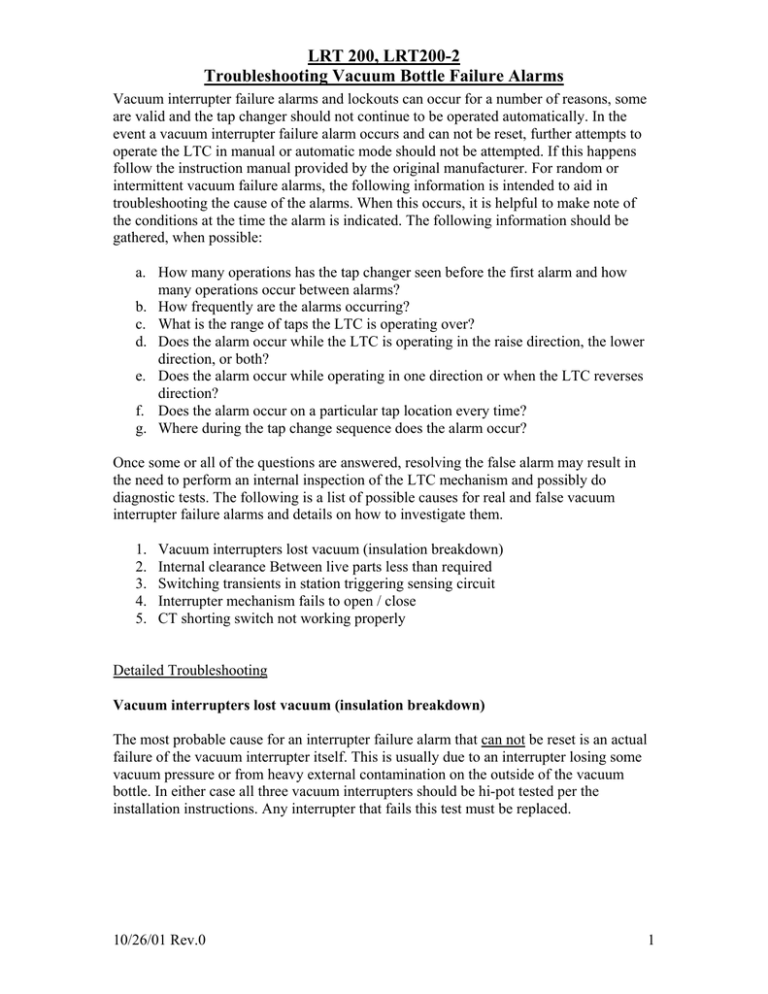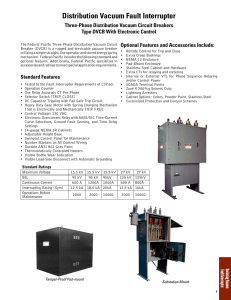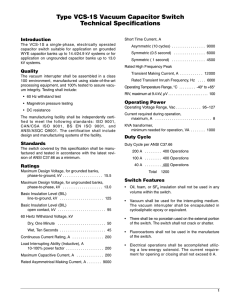Vacuum interrupter failure alarms and lockouts can occur for a
advertisement

LRT 200, LRT200-2 Troubleshooting Vacuum Bottle Failure Alarms Vacuum interrupter failure alarms and lockouts can occur for a number of reasons, some are valid and the tap changer should not continue to be operated automatically. In the event a vacuum interrupter failure alarm occurs and can not be reset, further attempts to operate the LTC in manual or automatic mode should not be attempted. If this happens follow the instruction manual provided by the original manufacturer. For random or intermittent vacuum failure alarms, the following information is intended to aid in troubleshooting the cause of the alarms. When this occurs, it is helpful to make note of the conditions at the time the alarm is indicated. The following information should be gathered, when possible: a. How many operations has the tap changer seen before the first alarm and how many operations occur between alarms? b. How frequently are the alarms occurring? c. What is the range of taps the LTC is operating over? d. Does the alarm occur while the LTC is operating in the raise direction, the lower direction, or both? e. Does the alarm occur while operating in one direction or when the LTC reverses direction? f. Does the alarm occur on a particular tap location every time? g. Where during the tap change sequence does the alarm occur? Once some or all of the questions are answered, resolving the false alarm may result in the need to perform an internal inspection of the LTC mechanism and possibly do diagnostic tests. The following is a list of possible causes for real and false vacuum interrupter failure alarms and details on how to investigate them. 1. 2. 3. 4. 5. Vacuum interrupters lost vacuum (insulation breakdown) Internal clearance Between live parts less than required Switching transients in station triggering sensing circuit Interrupter mechanism fails to open / close CT shorting switch not working properly Detailed Troubleshooting Vacuum interrupters lost vacuum (insulation breakdown) The most probable cause for an interrupter failure alarm that can not be reset is an actual failure of the vacuum interrupter itself. This is usually due to an interrupter losing some vacuum pressure or from heavy external contamination on the outside of the vacuum bottle. In either case all three vacuum interrupters should be hi-pot tested per the installation instructions. Any interrupter that fails this test must be replaced. 10/26/01 Rev.0 1 LRT 200, LRT200-2 Troubleshooting Vacuum Bottle Failure Alarms Internal clearance Between live parts less than required The minimum clearance required between any live potential on the LTC mechanism and ground or other potentials is 5/16”. If this minimum clearance is not maintained between the vacuum interrupter and leads, electrical discharges can occur resulting in an alarm and lockout. Visually inspect internal clearances of all leads on the LTC and look for evidence of arcing between leads or from leads to ground. Visually inspect each vacuum interrupter for signs of arcing at the ends of the vacuum interrupter to any lead routed near it. This could result in an alarm that may or may not be reset. Switching transients in station triggering sensing circuit Lockouts and alarms caused by this tend to be random in nature and easily correlated to switching events on the transformer or in close proximity to the transformer. A search for this should include checking all ground connections as well as control circuit connections to insure they are tight and the wiring is in good condition. A second cause of this could be the sensing circuit itself failing. If possible, a replacement sensing circuit can be installed to verify the circuit is operating properly. One other possible fix is to replace the original silicon controlled rectifier (SCR) # 2N1595 in the sensing circuit with a new SCR # 2N682 that is less sensitive to transients. The 2N682 SCR is a stud-mounted device so it would require drilling a hole in the control circuit board to mount it. It is recommended that you consult with a GE service representative for further details before attempting this fix. Interrupter mechanism fails to open / close A mechanical failure of the interrupter mechanism to open / close will typically result in an alarm that can be reset. This problem, even if intermittent, can usually be detected by visual inspection with the transformer de-energized and the LTC compartment open. The LTC can be operated both electrically and manually using a hand crank in the raise and lower directions while visually inspecting the operation of the interrupter assemblies. Obvious indications of problems include broken or binding parts associated with the vacuum interrupter assemblies, or arcing on the leading edges of the vacuum bypass blade and / or selector contacts. Other items to check here are as follows: A. Verify the vacuum interrupter pre-travel by measuring the gap between the upper actuator arm and the drive nut (refer to Fig. 1). This gap should be .125” +/- .010” with the vacuum interrupter in the closed position. This insures the drive nut strikes the upper actuator arm with enough force to throw the vacuum interrupter open. 10/26/01 Rev.0 2 LRT 200, LRT200-2 Troubleshooting Vacuum Bottle Failure Alarms Fig. 1: Checking the interrupter bottle pre-travel B. Carefully inspect the alignment of the hole through the upper actuator arm with respect to the 5/16” threaded stud going through it (refer to Fig. 2). If this stud is not centered in the hole of the upper actuator arm, the arm can bind on the threads of the stud and prevent the interrupter mechanism from operating freely. If this occurs the vacuum interrupter should be replaced. Fig. 2: Alignment of stud through upper actuator arm C. Carefully inspect the alignment of the movable shaft on the vacuum interrupter where it passes through the hole in the upper actuator arm to insure there is no binding between the parts (refer to Fig. 3). If the vacuum interrupter is not centered through the hole in the arm and is binding during operation the vacuum interrupter mechanism should be replaced. 10/26/01 Rev.0 3 LRT 200, LRT200-2 Troubleshooting Vacuum Bottle Failure Alarms Fig. 3: Alignment of vacuum interrupter shaft through upper actuator arm D. With the LTC off position and the vacuum interrupter open, release the latch block on the interrupter assembly with one hand while squeezing the upper actuator arm towards the interrupter mounting bracket to close the vacuum interrupter (refer to Fig.4). Do this on all three phases several times to insure the vacuum interrupter operates freely. Any signs of binding or slow operation should be investigated further and / or replacement of the suspect vacuum interrupter assembly be performed. Fig. 4: Operating the vacuum interrupter assembly by hand E. Verify the wear indicator pin is centered in the hole of the wear indicator plate, and that it moves freely through the hole in the back side of the dashpot on top of the interrupter assembly. 10/26/01 Rev.0 4 LRT 200, LRT200-2 Troubleshooting Vacuum Bottle Failure Alarms F. Verify the dashpot baffle plate is not binding by inserting a small rod through the holes of the dashpot assembly and push down on the baffle plate (refer to Fig 5). If this plate is binding and not moving freely sluggish operation of the vacuum assembly can occur possibly resulting in vacuum failure alarms. Fig 5 Checking Dashpot Baffle Plate Movement G. Verify the auxiliary cam and roller on the dual slope cam assemblies that control the opening and closing of the interrupter assemblies operate freely. Push / pull auxiliary cam with the LTC on position to insure it moves freely and the follower roller stays within the “V” shaped portion of the auxiliary cam (refer to Fig 6 & 7). Binding of the auxiliary cam against the center cam can result in the interrupter not opening properly. 10/26/01 Rev.0 5 LRT 200, LRT200-2 Troubleshooting Vacuum Bottle Failure Alarms Fig. 6 & 7: Verifying auxiliary cam operation CT shorting switch not operating properly The timing and operation of the CT shorting switch is critical to proper operation of the vacuum interrupter failure sensing circuit. During a tap change operation, the CT shorting switch should open just after the vacuum interrupters open and close just before the interrupters close. If it opens prior to the interrupters opening or closes after the interrupters closing, a false failure alarm will occur. Proper CT shorting switch operation can be checked by using an ohm meter to indicate if the switch is opening and closing as expected. Proper sequence of the CT shorting switch with the interrupters can be verified by visual observation. If the sequence of switching does not occur in the proper order, vacuum interrupter failure alarms can occur. 10/26/01 Rev.0 6



